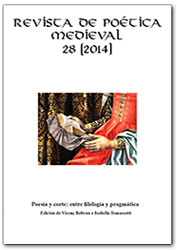«De la doble versión al poema fantasma: la creatividad de la imprenta»
DOI:
https://doi.org/10.37536/RPM.2014.28.0.53206Resumen
Resumen: Tras una introducción sobre los cambios que introdujo la imprenta en la difusión de la literatura medieval y en su textualidad, se analizan dos poemas de Ausiàs March (el 102b y el 103) en la forma que han sido transmitidos por la edición de Juan de Resa (Valladolid, 1555). Plantea la posibilidad de que dichos poemas sean producto de una operación editorial a partir del conocimiento por parte de Juan de Resa de dos tradiciones textuales totalmente diferentes, sin querer renunciar a ninguna de ellas.
Palabras clave: Ausiàs March. Transmisión textual. Imprenta. Impresos.
Abstract: After an introduction on the changes introduced by the printing press in the diffusion of medieval literature and its textuality, two Ausiàs March’s poems (102b and 103) are analysed as they have been transmitted by the edition of Juan de Resa (Valladolid, 1555). The paper suggests the possibility that these poems are a product of a publishing operation based on Juan de Resa’s knowledge of two completely different textual traditions, not wanting to give up any of them.
Keywords: Ausiàs March. Textual transmission. Printing. Printed books.
Descargas
Métricas alternativas
Descargas
Cómo citar
Número
Sección
Licencia
Las opiniones y hechos consignados en cada artículo son de exclusiva responsabilidad de sus autores. La Universidad de Alcalá no se hace responsable, en ningún caso, de la credibilidad y autenticidad de los trabajos.
Los autores conservan los derechos sobre sus trabajos, aunque ceden de forma no exclusiva los derechos de explotación (reproducción, edición, distribución, comunicación pública y exhibición) a la revista. Los autores son, por lo tanto, libres de hacer acuerdos contractuales adicionales independientes para la distribución no exclusiva de la versión de la obra publicada en la revista (por ejemplo, alojarlo en un repositorio institucional o publicarlo en un libro), siempre que medie un reconocimiento de su publicación inicial en esta revista.
Los trabajos se publican bajo los términos estipulados en la Licencia de Atribución-NoComercial-CompartirIgual 4.0 Internacional Creative Commons (CC BY-NC-SA 4.0) que permite a terceros compartir la obra bajo las siguientes condiciones:
Atribución — Usted debe dar crédito de manera adecuada, brindar un enlace a la licencia, e indicar si se han realizado cambios. Puede hacerlo en cualquier forma razonable, pero no de forma tal que sugiera que usted o su uso tienen el apoyo de la licenciante.
NoComercial — Usted no puede hacer uso del material con propósitos comerciales.
CompartirIgual — Si remezcla, transforma o crea a partir del material, debe distribuir su contribución bajo la misma licencia del original.










